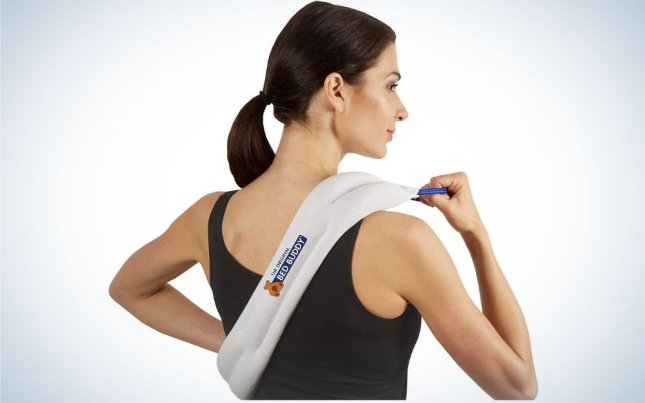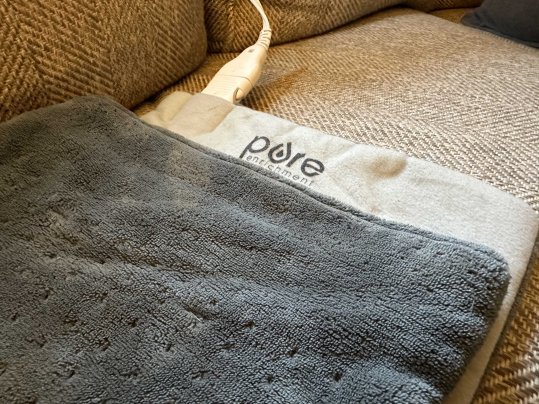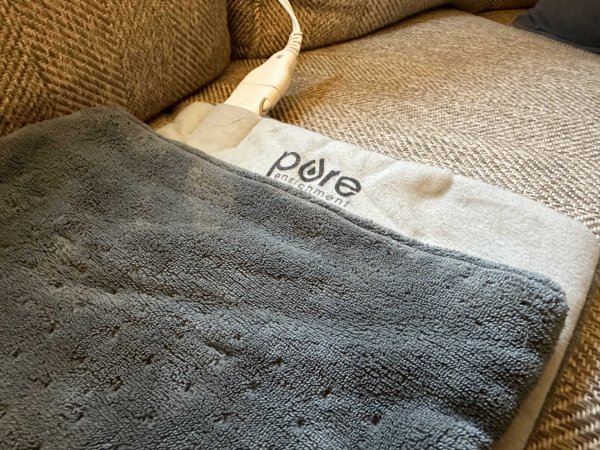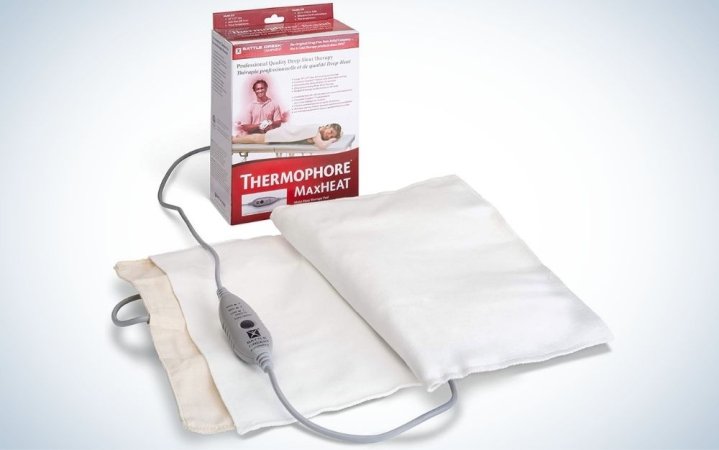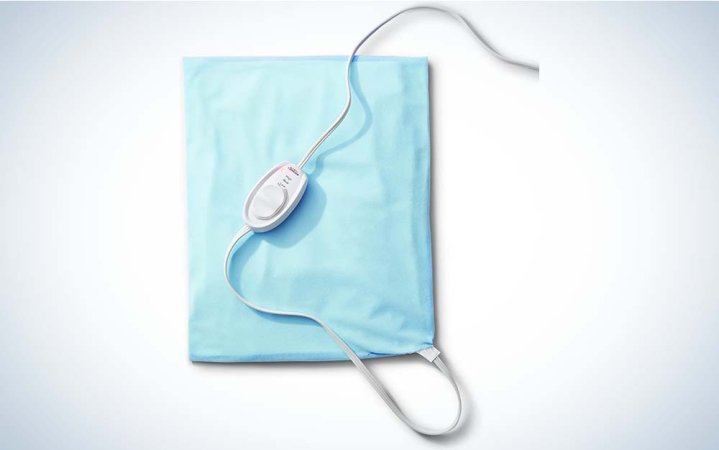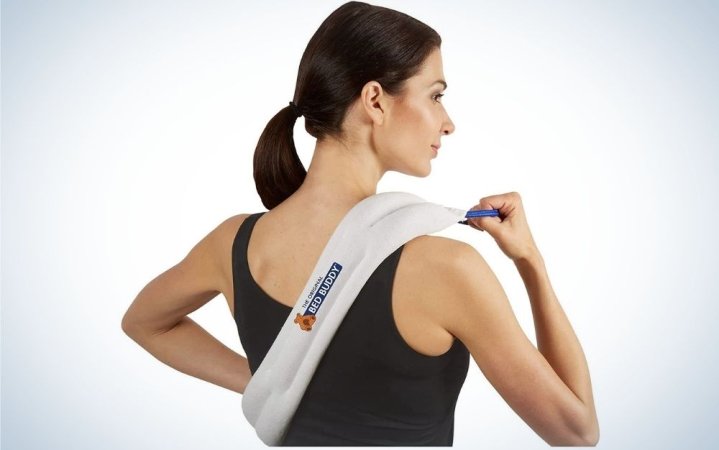We may earn revenue from the products available on this page and participate in affiliate programs. Learn more ›
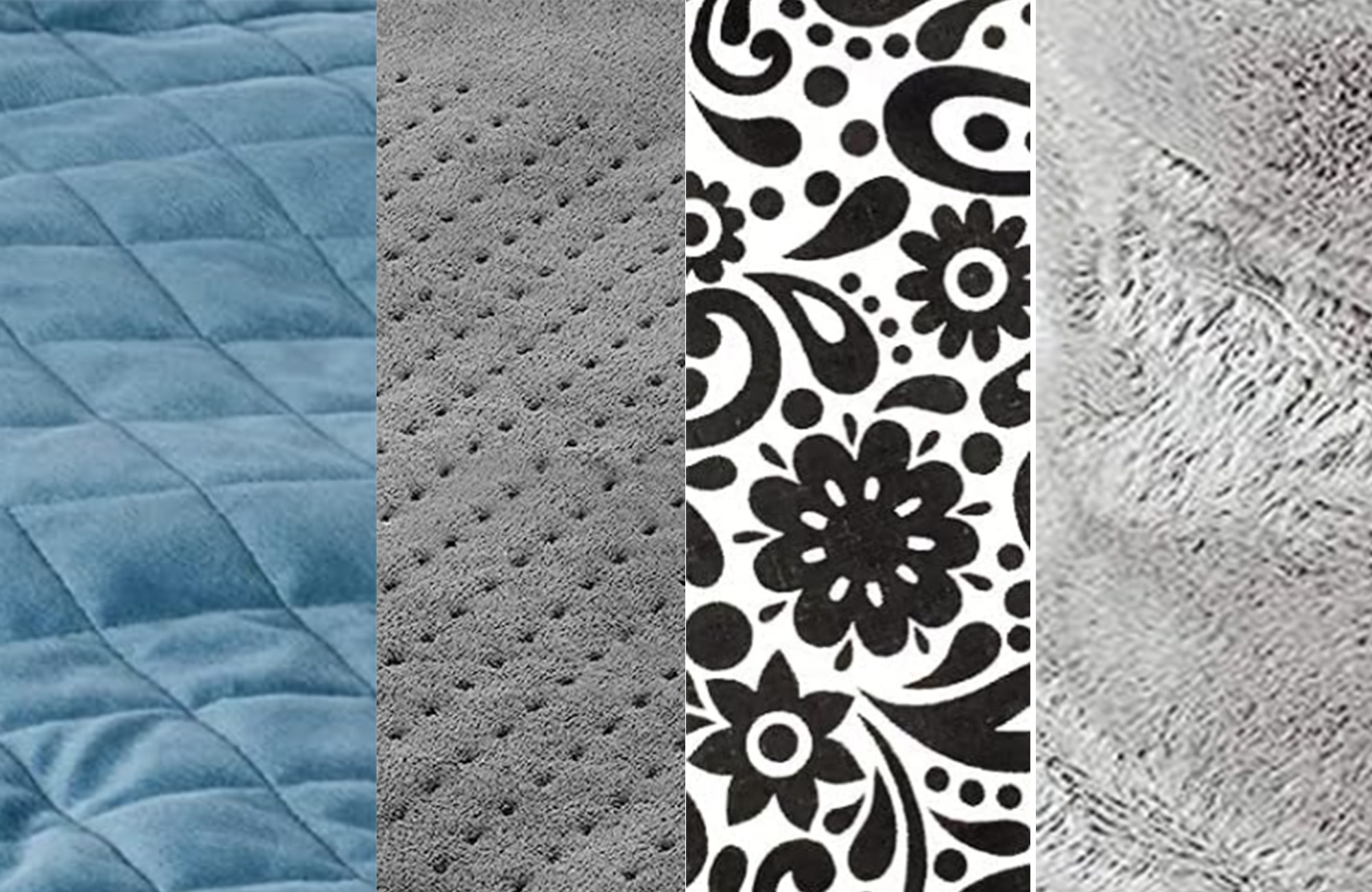
If you’ve got tense, sore, or injured muscles, consider heating pads before you reach for aspirin. They stimulate blood flow, help muscles relax, and offer fast pain relief. They come in different shapes and sizes to fit various areas of the body. Different types of heating pads, like weighted and microwaveable models, feature designs that fit certain needs and preferences. If you have problem areas, some models can mold to or specifically fit the shoulders, neck, or lower back. In addition, some heating pads can shape themselves to most areas of the body, so you can use the same one even if you’ve got many different sore spots. So get ready for some heat, and look at the best heating pads, along with tips on choosing the right one for your aching body.
- Best overall: Pure Enrichment PureRelief Ultra-Wide Microplush Heating Pad
- Best for cramps: Sunbeam Cordless Heating Pad
- Best for arthritis: Thermophore MaxHeat Arthritis Pad
- Best for neck and shoulders: Sunbeam Heating Pad for Neck & Shoulder
- Best moist: Sunbeam Heating Pad for Back, Neck, and Shoulder Pain Relief
- Best weighted: Pure Enrichment WeightedWarmth 2-in-1 Weighted Body Pad
- Best eco-friendly: Caylee’s Creations Microwavable Corn-Filled Heating Pad and Cold Pack
- Best budget: Carex Bed Buddy Heat Pad and Cooling Neck Wrap
How we chose the best heating pads
At PopSci, we have an affinity for products that help keep readers warm, from the best heated clothing to the best electric garage heaters to the cousin of heating pads, the best heated blankets. In compiling our list of the best heating pads, we looked for options that served various needs, from arthritis and neck and back pain, to heating pads that just help keep people warm. We looked for heating pads from trusted brands like Sunbeam and Carex. We also considered user reviews in making our recommendations.
The best heating pads: Reviews & Recommendations
Both heat and cold can help soothe aches and pains. Heat attracts more blood flow and nutrients to the affected areas, helping to provide relief, according to WebMD. Heating pads can offer different types of heat, control features, and designs that make some pads more helpful under certain circumstances. For example, there’s dry heat, and there’s moist heat. Both types of heat are helpful, but there’s evidence that moist heat’s ability to penetrate soft tissue faster can boost the pad’s effectiveness. So, if you’re looking for the best heating pad for cramps, arthritis, neck and shoulders, or general muscle pains, our recommendations have you covered.
Best overall: Pure Enrichment PureRelief Ultra-Wide Microplush Heating Pad
Best overall
Pure Enrichment PureRelief Ultra-Wide Microplush Heating Pad
Pros
- Cozy
- Six temperature settings
- Provides dry and moist heat therapy
- Automatic shutoff after 2 hours
Cons
- Some users said it stopped working consistently
Specs
- Material: Microplush polyester, plastic
- Heat range: 105-140℉
- Size: 24 inches L x 20 inches W
- Weight: 1.9 pounds
Pure Enrichment’s PureRelief Ultra-Wide Microplush Heating Pad is a cross between a super comfy blanket and a heating pad you can fine-tune to your preferences. Made of microplush, this heating pad provides six heat levels, which you can adjust using an ergonomic LCD controller. It’s designed to heat up instantly, and you can select between 105-140℉ of heat. You can also switch between dry and moist heat by dampening the pad. And automatically shuts off after 2 hours, should you doze off.
At just 1.9 pounds, this heating pad is lightweight, but its dimensions of 20 by 24 inches provide plenty of coverage for neck, shoulders, back, and legs. It provides plenty of warmth and relief for muscle soreness and joint pain. Plus, it’s machine-washable.
Best for cramps: Sunbeam Cordless Heating Pad
Best for cramps
Sunbeam Cordless Heating Pad
Pros
- Portable
- Modern design
- Operates at 60 hertz
- Works on multiple parts of the body
- Machine-washable cover
Cons
- Battery may run out
Specs
- Material: Micromink (double-sided polyester), lithium-ion battery
- Heat range: Low to high
- Size: 12 inches L x 9.5 inches W
- Weight: One pound
Looking for targeted relief from cramps? Sunbeam’s Cordless Heat Pad is designed with a microplush covering that measures 12 inches by 9.5 inches, and strap that adjusts up to 55 inches. This heating pad provides three levels of heat and is battery-powered so that you can wear it around your home. The lithium-ion battery also runs for up to 4 hours on a single charge and runs at a frequency of 60 hertz. You can also use it on your back, neck, shoulders, and legs. Once you’re feeling better, the cover is removable and machine-washable.
Best for arthritis: Thermophore MaxHeat Arthritis Pad
Specialized Comfort
Pros
- Temperature goes higher than some other options
- Shuts off after 25 minutes
- Easy to clean
Cons
- Some users say you can’t return it
Specs
- Material: Fleece, plastic
- Heat range: 50 to 165°F
- Size: 14 inches W x 27 inches L
- Weight: N/A
The Thermophore MaxHeat Arthritis Pad heats quickly and reaches temperatures between 150 to 165°F. The intense, moist heat is delivered by a large 14- by 27-inch pad. With three heat settings and an automatic 25-minute shutoff feature, this portable heating pad relieves pain but keeps you safe, too.
Best for neck and shoulders: Sunbeam Heating Pad for Neck & Shoulder
Shaped for Relief
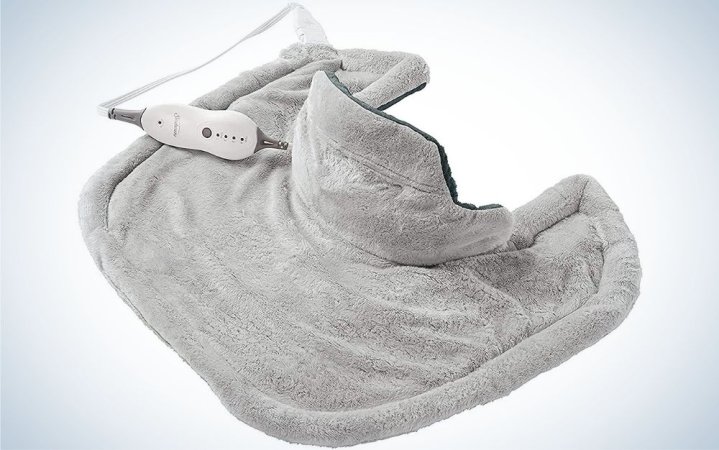
Pros
- Fits to your shoulders and neck
- Very soft
- Close fit
Cons
- Some users say the heat is uneven
- Cord is bulky
Specs
- Material: Micromink, plastic
- Heat range: Max of 176°F
- Size: 22 inches L x 19 inches W
- Weight: 2.7 pounds
The Sunbeam Heating Pad for Neck & Shoulder features an extra-tall, adjustable collar to cover the entire back of the neck and into the scalp. In total, this pad measures 22 by 19 inches, making it large enough for men and women. The Sunbeam also includes four heating settings and a removable, washable cover made of soft micromink. Meanwhile, you can keep your feet warm with some of the best heated insoles or best heated slippers.
Best moist: Sunbeam Heating Pad for Back, Neck, and Shoulder Pain Relief
Best budget
Sunbeam Heating Pad for Back, Neck, and Shoulder Pain Relief
Pros
- Affordable
- Lightweight
- Easy to clean
Cons
- May not cover as much of the body as other options
- Not as cozy as other picks
Specs
- Material: Polyester, vinyl
- Heat range: 110 to 160°F
- Size: 12 inches x 15 inches
- Weight: One pound
If you’re looking for an inexpensive heating pad that provides moist heat, consider the Sunbeam Heating Pad for Back, Neck, and Shoulder Pain Relief. At 12 inches by 15 inches, this electric heating pad can help provide relief to a smaller area than some other heating pads. But you can adjust the temperature in the three settings, ranging from 110 to 160°F. Designed to help with arthritis, shoulder, neck, and back pain, this heating pad is also equipped with a sponge insert to provide moist heat in addition to dry heat. Plus, you can remove the cover to wash it.
Best weighted: Pure Enrichment WeightedWarmth 2-in-1 Body Pad
Close Fit

Pros
- Weighted blanket and heating pad in one
- Plush
- Non-toxic
- More attractive than other options
Cons
- Some users had problems getting it to heat up
- Glass beads may bunch
Specs
- Material: Micromink, glass beads
- Heat range: 105-140℉
- Size: 32 inches L x 21 inches W
- Weight: 6 pounds
The Pure Enrichment WeightedWarmth 2-in-1 Body Pad is made of a diamond quilted mink. Each diamond contains non-toxic beads that help the pad conform to the shape of your shoulders, leg, or back. The quilting maintains an even distribution of the beads, so there’s no pooling. That also maintains the pad’s contouring so it can better reach tight, sore muscles. Want to explore the psychological benefits of weighted blankets minus the heat? We’ve got a guide for that, too.
Best eco-friendly: Caylee’s Creations Microweavable Corn-Filled Heating Pad and Cold Pack
Best eco-friendly
Caylee’s Creations Microwavable Corn-Filled Heating Pad and Cold Pack
Pros
- Made of natural materials
- Microwaveable
- Provides both heat and cold therapy
Cons
- Can’t adjust temperature
- May not be the best solution for arthritis or chronic pain
Specs
- Material: Cotton and corn
- Heat range: N/A
- Size: 7.5 inches W x 11 inches L; 5.25 inches W x 17.25 inches L
- Weight: 2.8 pounds
If you’re looking for a low-tech heating pad that’s made from natural materials, consider Caylee’s Creations Microwavable Corn-Filled Heating Pad and Cold Pack. Yes, you read that right: corn-filled. When you heat one of these heating pads up in the microwave, it smells like popcorn. If you want cold relief instead, you can just pop this heating pad in the freezer. It’s available in two sizes (7.5 inches wide by 11 inches long and 5.25 inches wide by 17.5 inches long), and you can choose from 25 colorways and designs, including polka dot, plaid, and camo. And the 100 percent cotton cover is removable for washing.
Best budget: Carex Bed Buddy Heat Pad and Cooling Neck Wrap
Hot or Cold
Pros
- Comes in four versions (unscented, Balance Orange, Bliss Pink, Fresh Green)
- Provides both hot and cold therapy
- Inexpensive
Cons
- May not provide heat and cold consistently
Specs
- Material: Nylon handles, natural filling (herbs, flowers)
- Heat range: N/A
- Size: 23 inches L x 4.25 inches W
- Weight: 2 pounds
The Carex Bed Buddy Heat Pad and Cooling Neck Wrap contains an organic filling of grains and herbs that holds heat or cold. Pop it in the microwave to create moist heat, or store it in the freezer for a cooling wrap to treat swelling or injury. Handles on either end help it stay in place, or press the heating pad into the skin for deeper heat penetration.
What to consider before buying a heating pad
Whether you’re looking for a comfy heating pad to wrap your tired muscles in after a long, cold run, or you’d like to reduce tension in your neck, our recommendations can help address your needs. To find the option that’s the best for you, consider these factors:
Levels of heat
Heating pads with multiple or adjustable heat settings give you more control over your heat therapy. Areas of the body that don’t have a lot of soft tissue, like the ankle, may need less heat than the thigh, for example, where there’s ample soft tissue to disperse the heat. Of course, there are also comfort preferences and heat tolerance that may necessitate temperature adjustment. And those with a single heat setting may need closer monitoring to ensure the temperature stays comfortable.
Location of pain and fit
Back pain, specifically low-back pain, causes more global disability than all other pain sources. Heat can help, whether that pain comes from overuse or stems from a chronic condition. Heating pads designed for back pain may be a simple rectangle shape that molds to the body. This type works for the back, but also for general pain in other areas of the body.
Other designs fit like a vest or jacket, allowing freedom of movement with the arms. These electric heating pads aren’t usually battery-powered. Consequently, you can’t walk around while wearing one, but the pad will fit and stay in place better. However, these close-fitting designs can cause overheating, so pay attention to how you feel. Red skin, lightheadedness, or an upset stomach could indicate that you or your skin are overheating, and it’s time to take the pad off.
That said, a rectangle isn’t always the best shape for the body’s curves. Shoulder and neck pain are common complaints that may not get the heat they need from a standard rectangular heating pad.
To address that need, neck-and-shoulder heating pads are made in the shape of the neck and/or shoulders with a collar and body that drapes across the shoulders and partially down the back. Some are for the neck only, and others are shoulders only. However, the magical ones do both at once. Look for a model that fits your body size and drapes far enough down the body to reach your problem areas.
Moist vs. dry heat
Heat is heat, right? Wrong. Moisture can help the heat penetrate deeper into the soft tissues and amplify the effects. The most efficient and consistent moist heating pads absorb moisture from the air, heat it, and let it penetrate the body. They don’t run out of moisture and keep heat exposure consistent.
Look for models with adjustable temperature settings. Moist heat feels hotter and can easily burn the skin. Moist heating pads can also welcome mold and mildew if they aren’t maintained properly. Make sure that it is completely dry before putting it away.
Electric vs. microwaveable
Microwavable heating pads have two key benefits. First, they don’t require an electrical cord. You can manipulate the pad and adjust it to the body without wrestling with a cord. A lack of cord also lets you walk around with it in place.
The second benefit is that some microwaveable heating pads offer moist heat. Some models allow you to put a small bowl of water in the microwave with the heating pad. The water releases steam, which the pad absorbs. It then releases that moisture against your body, letting the steam penetrate deeper into the tissue.
The downside of these pads is that you have to be careful with them initially as they may be very hot, but they lose their heat relatively quickly. At that point, you’ll have to reheat them, but it’s a small price to pay for mobile heat.
Safety
It’s important to note that heating pads, when not used properly, can cause a burn or be a fire hazard. Safety features like an automatic shut-off and an internal thermometer prevent heating pad burns and fire. Some models feature a timer that shuts the heat off after 20 to 30 minutes, while others turn off once they reach a certain temperature. However, safety also requires that the user follow the manufacturer’s guidelines.
As far as safe use, don’t lay on a heating pad, which can trap heat against your body and potentially cause a burn or start a fire. Do not place the pad directly on your skin, and make sure you don’t fall asleep with one, even if it has an automatic shut-off feature.
Weight
Weighted heating pads do a couple of things that other models don’t. First, they offer a better fit against the body. If there’s a gap between the pad and the body, heat cannot penetrate as well, and you might not get all of the benefits. Weighted models mold to the body and stay in place more readily, so you get a good fit no matter the pad’s placement.
Second, weight and pressure have also been shown to help relieve anxiety. These heating pads can act as a mini weighted blanket while providing relaxing heat. It’s kind of a win-win situation—a better fit and relaxing heat all in one. If you’re looking for a DIY heating pad, you can fill an old sock with rice and heat it in the microwave, or warm towels. Just be careful of the heat when you first handle a homemade heating pad.
FAQs
Heating pads range in price from about $85 for a higher-tech portable option like the Sunbeam Cordless Heating Pad to under $10 for the microwaveable Carex Bed Buddy Heat Pad and Cooling Neck Wrap.
Heating pads are an excellent option for shoulder pain. The trick is getting a good fit to the part of the shoulder that hurts. Rectangular models can work. However, you’ll get better relief with one designed to fit around the neck and shoulders. Weighted models can also help the pad mold to your shape for a closer fit and better heat application.
You should exercise care when using a heating pad. Some can reach temperatures more than 175°F on the highest settings and microwaveable options can be very hot when initially heated. Many of the electric heating pads are designed with automatic shutoffs, but you should limit the time you use one at high settings.
Yes, you can use a heating pad while pregnant to help alleviate back pain. The American College of Obstetricians and Gynecologists recommends that you use the lowest temperature setting and wrap the heating pad in a towel to protect against burning. You should also limited the time you use a heating pad. Using the cold function of a heating pad can also provide relief for back pain.
No. You should not sleep with a heating pad every night. Even with a timer, there’s a risk of falling asleep, getting a burn, or potentially starting a fire. It’s OK to use a heating pad in bed as long as you’re awake, then take it out of bed when you’re done, and turn it off.
Laying on a heating pad is a universal no-no. It traps heat and can potentially cause a burn or pose a fire hazard.
Final thoughts on the best heating pads
- Best overall: Pure Enrichment PureRelief Ultra-Wide Microplush Heating Pad
- Best for cramps: Sunbeam Cordless Heating Pad
- Best for arthritis: Thermophore MaxHeat Arthritis Pad
- Best for neck and shoulders: Sunbeam Heating Pad for Neck & Shoulder
- Best moist: Sunbeam Heating Pad for Back, Neck, and Shoulder Pain Relief
- Best weighted: Pure Enrichment WeightedWarmth 2-in-1 Weighted Body Pad
- Best eco-friendly: Caylee’s Creations Microwavable Corn-Filled Heating Pad and Cold Pack
- Best budget: Carex Bed Buddy Heat Pad and Cooling Neck Wrap
Sweet relief is only a button touch away when you’ve got the best heating pad waiting for you. Whether it’s a moist heating pad, electric model, or microwavable, there’s a model that will fit your body and budget. Make sure it’s got safety features, even heat distribution, and the coverage your aching body needs. Now, it’s time to sit down, turn on the heat, and relax.
